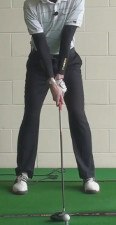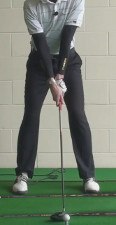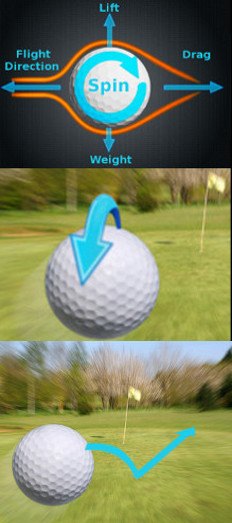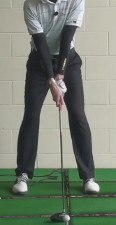
It's widely recommended that you set up to the driver with the ball positioned directly opposite your left heel (right heel if you're left-handed). This positions you to catch the ball while the club is moving level with the ground or slightly on the upswing, making full use of the driver's loft and boosting your carry yardage.
However, many golfers go too far. At address, the ball is in line with the left big toe, or even farther out in extreme cases. This prevents them from shifting enough weight from right to left on the through-swing; also, the club has already begun moving left of the target by the time it reaches the ball.  In both cases, the most common result is a slice (though some will suffer a pull).
In both cases, the most common result is a slice (though some will suffer a pull).
If you struggle with a slice, try moving the ball slightly back in your stance. You'll catch it while the club is moving directly toward the target or to the right, both far preferable to your current swing path.
Here's an easy way to check your ball position on the range:
- Tee up a ball and place a club a few inches inside it, pointed directly at the target.
- Place a second club inside your toe line, parallel to the first.
- Place a third club perpendicular to the others and pointing directly at the ball.

- Set up to the ball and align your feet with the second club.
- The third club will show you where the ball is positioned relative to your left heel.
Another simple method is to address the ball in your usual manner, then drop the club to the ground. The grip will point to your ball position.

Play the Ball Back to Improve Driving Accuracy?
In the modern age of golf, everyone is obsessed with driving distance. If you were to talk to the average golfer about what his or her goals are for the next golf season, it wouldn't be long before they mentioned adding distance to their drives. Despite this obsession, driving distance isn't actually that closely related to scoring average. Sure, longer drives can help, but only if you have the ability to control the ball nicely off the tee.
In this article, we are going to skip over the topic of driving distance, and instead focus our attention on driving accuracy. If you can hit more fairways, you are almost certain to play better golf – even if you give up a few yards in the process. Simply put, the game of golf is easier when played from the middle of the fairway. You'll have more fun when you are able to hit accurate drives, and your scores will be lower as well. If you can set your ego to the side and prioritize accuracy over distance, you are sure to become a better player.
The specific question we are going to tackle in this article is whether or not you can improve your driving accuracy by moving the ball back in your stance. It is common for golfers to use this tactic when hitting approach shots, but this method is not used nearly as often from the tee. So, is this a good idea? As you are going to see throughout this article, there are pros and cons to using this concept. Sometimes, it can be an effective way to improve your odds of hitting the fairway. Other times, however, it is an idea which is best left in the bag. Hopefully, by the end of this article, you will understand what happens when you move the ball back in your stance, and you will be able to pick out the proper times to give this a try.
Of course, moving the ball back in your stance is not the only way to improve your accuracy off the tee. You can also work on tweaking your equipment, improving your overall swing technique, finding better strategies, and more. One of the great things about golf is that you will never achieve perfection – there are always opportunities to get better. Keep thinking about how you can improve your game and continue to pursue progress until you reach your goals on the links.
All of the content below is based on a right-handed golfer. If you happen to play left-handed, please take a moment to reverse the directions as necessary.

A Few Benefits
There are no perfect techniques in golf, as everything you decide to do with your swing can be seen as a tradeoff. All golf shots come with pros and cons, and the story is no different when talking about hitting tee shots from back in your stance. There are some positive aspects to using this approach, and there are some problems as well. In this section, we are going to highlight the benefits that would encourage you to go in this direction. Later, we'll talk about some of the issues you may run into when trying this method.
For an understanding of what can be gained when you play the ball back in your stance off the tee, check out the list below.
- Tighter dispersion. By moving the ball back in your stance, you should be able to narrow the overall pattern of your shots throughout the course of a round. In other words, your misses should be more playable, while your good shots will still find the center of the fairway. One of the best ways to lower your average score is to avoid making big mistakes off the tee. Even if you hit only one or two bad misses throughout a round, each of those misses could cost you a couple strokes – if not more. By narrowing your misses and keeping the ball on the golf course, you can avoid penalty strokes and bring your scores down as a result. This benefit should be seen as one of the primary reasons to consider playing the ball back in your stance. Limiting the damage when you hit a poor drive is going to go a long way toward making you a better player.
- Simplified swing. To achieve consistent results, you want to make a simple, repeatable golf swing. Moving the ball a bit back in your stance may help you do just that. With the ball closer to the middle of your stance than the front, you will be less inclined to move laterally during the swinging action. Taking lateral movement out of your swing is a great way to simplify the process, and you should achieve more consistent outcomes as a result. Once you get comfortable with this kind of technique, you will likely grow to appreciate how helpful it can be when it comes to creating reliable, consistent results off the tee. It is tempting to add all sorts of different moves and techniques into your swing, but it is usually the golfers with the simple actions that come out on top in the end.
- A clean strike. All golfers enjoy the feeling of a well-struck shot at the moment of impact. When you hit the ball just right, you don't really even need to look up to watch it fly – you already know it is going to be headed straight for the target. Of course, these solid strikes tend to be rather elusive in the amateur game, taking place only a few times per round (if that). If you would like to enjoy this feeling on the tee more frequently, consider playing the ball back in your stance a bit. By hitting down on the ball more aggressively – which is likely to happen when you move the ball back – you should be able to find the sweet spot with increased frequency. There is no guarantee that you are going to hit all of your tee shots cleanly this way, but it's a safe bet that your percentage will improve after making this adjustment.
- Control in poor conditions. Golf becomes more difficult when the weather conditions turn against you. Of course, you already know that. If you are playing a round in bad weather, setting up with the ball near the back of your stance is a great way to improve control and keep the ball in play. Especially on windy days, where slightly miss-hit shots can be badly punished, moving the ball back a bit is a great way to go. With that said, you already need to be comfortable with this technique in order to use it on an ugly weather day. If you simply see that the weather is bad and decide to try this on the fly, it isn't going to work out in your favor.
As you can see, there is plenty to like about moving the ball back in your stance on the tee. This is not a perfect technique – as we will see in the next section, but it does have some beneficial traits to offer your game. When used at the right time, this kind of tee shot is just another valuable tool you can have in your golf arsenal.

The Drawbacks
It would not be fair to highlight the benefits of this shot without touching on the drawbacks as well. You are going to have to make some sacrifices if you use this method, and in many cases, those sacrifices will not be worth the benefits when considering the shot at hand. Ultimately, this is your main challenge in golf, whether on the tee or on any other part of the course. You have to determine when to use which shot, based on the design of the hole, the weather, and many other factors. Good golfers not only make quality swings, they also choose the right shot at the right time.
Consult the following list to learn what you will be giving away if you decide to move the ball back in your stance on the tee.
- Distance loss. This is the major drawback of using this technique from the tee. With very few exceptions, you are going to hit the ball a shorter distance when you play the ball farther back in your stance. There are a couple of reasons for this distance loss. For one thing, there isn't going to be as much room between the club at the top of the swing, and the ball. With a shorter overall distance to work with in the downswing, the acceleration phase of the wing will be shortened, and you will have less swing speed at the moment of impact. Also, by swinging down into impact, you are going to impart extra backspin on the ball, and you'll likely lose a little distance there as well. The amount of distance you lose is going to depend on the club you are swinging, how far the ball is moved back in your stance, and the conditions in front of you. Of course, it needs to be said that losing distance is not always a bad thing. When trying to emphasize control, it is perfectly acceptable to sacrifice distance for an improved likelihood of hitting the fairway. Once you learn how to use these kinds of tee shots, you will have to decide when it is okay to sacrifice distance, and when you should use a style of shot that is going to let you maximize yardage.
- Potential for too much backspin. As mentioned in the previous point, you are probably going to increase your backspin rate when you hit this shot. Why? Simple – when you hit down on the ball, as you will do when it is farther back in your stance, your spin rate is going to increase. It should be pointed out that adding spin does not necessarily mean the ball will fly higher, as you are going to lower your launch angle at the same time. So, you might wind up with a somewhat low, 'spinny' shot, which can be tricky to use. If you do hit tee shots with the ball back in your stance, it will be important to manage your spin rate effectively. We will provide some tips on this point later in the article.
- May be difficult to aim. Believe it or not, some golfers struggle to hit accurate tee shots this way just because they aren't able to aim down the middle of the fairway. It can be tricky to determine where your club face is aiming at address when the ball is back in your stance, so you may make alignment mistakes as a result. Specifically, it is easy to find yourself in a spot where you are aiming too far to the right of the target. Should you decide to use this shot, it will be necessary to put in plenty of practice on the range to get comfortable with the aiming process.
The drawbacks of this shot are not to be overlooked. You shouldn't expect to move the ball back in your stance and immediately begin hitting long, powerful drives right down the middle. That's not how it works. You can likely make improvements in your driving accuracy when you move the ball back, but those improvements will be offset by some of the drawbacks listed above. In the end, this is the kind of shot that can be useful in some situations, while mostly useless in others. Once you learn how to spot the right opportunities, you'll be able to count this piece of technique as an asset.






